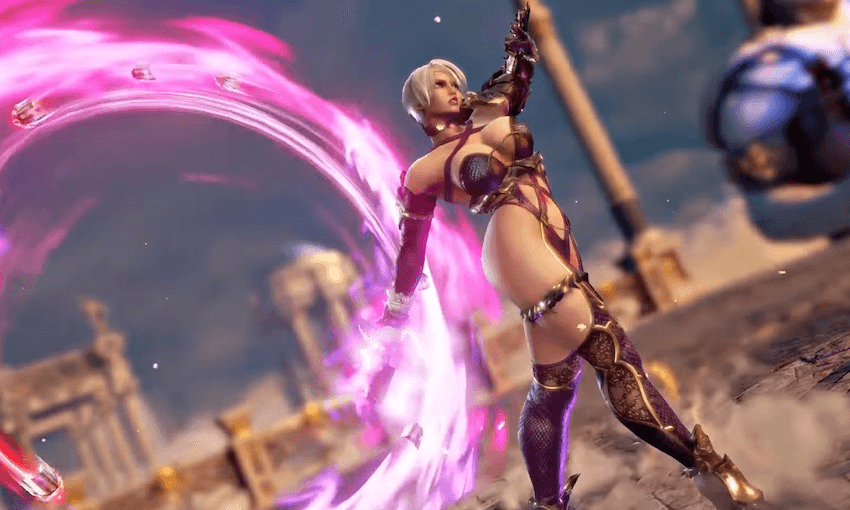Does my soul still burn? After six years, kind of! Sam Brooks reviews Soul Calibur 6.
It feels appropriate to start this review of a fighting game by admitting I used to be the kind of person who beat semi-experienced players in Tekken 3 as Eddy by button-mashing. If one was to ever call into question my game-reviewing credentials, now would be the time.
In a more relevant example, I’m also the person who made their way through Soul Calibur 2′s Conquest Mode by spamming Seong-Mina’s A+B move. So, again, credentials, grains of salt, let’s continue.
To say that Namco shit the bed entirely with Soul Calibur V would be charitable. They gave the series, with its already convoluted and slow-moving canon, a time-jump, ditched many of the beloved older characters in favour of a new generation and gutted the story mode until it was barely a shell. The game was rebalanced for competitive play, and just about everybody was disappointed like it. It seemed like the end of the series.
Until, just under a year ago, when newly minted producer Masahiro Okubo stepped up to the podium at the Game Awards in Los Angeles and asked the simple question, “Do your souls still burn?” And so the game’s return was announced.
And now we have, ladies and otherly identified, Soul Calibur 6.
The main goal with Soul Calibur 6 is twofold, as far as I can tell.
Firstly, it’s to introduce people to the series – or, to be more accurate, re-introduce people to the series. As in, who the hell are these characters, and why does that lady have no clothes on and a sword that turns into a whip?
Soul Calibur 6 takes players right back to Soul Calibur to retell that original story – essentially how the evil sword Soul Edge was defeated and its spread across 16th century Europe and Asia was stopped. And… look, going into a fighting game for the story will always lead to disappointment. If you’re into the specific kind of shōnen manga-vibe that Soul Calibur happily peddles, then you’ll be happy as hell here. If you’re looking for Proust, then go read a book, nerd.
Much better is the way the story is structured and delivered, which lends itself well to both longtime fans and newcomers. There’s an overarching main story, Soul Chronicle, that takes about an hour to play through – including beautiful hand-painted-esque story scenes provided by popular SNK illustrator Hiroaki – and individual stories for each of the characters, which will take you about half an hour each. If you want to know exactly why that lady is wearing no clothes and why her sword can turn into a whip, Soul Calibur 6 is here to school you. And if you’re an old pro who just wants to see Ivy Valentine chain-sword her way through mooks, there Soul Calibur 6 is here for you too.
It can get a little bit repetitive, and I can’t recommend playing through all twenty-one story modes in one sitting, but for a story mode in a fighting game, it’s pretty robust, especially when you consider the one- or two-mission long story modes that Tekken 7 gave each character barely a year ago. On top of this story mode, however, is Libra of the Soul mode, which lets a created character rage through the barely historical landscape of 16th century Europe/Asia. If the Soul Chronicle Mode is a shōnen manga, then Libra of the Soul is closer to a game of D&D set in a familiar world. Again, it gets repetitive, but if you’re jumping in and out as infrequently as you would for a D&D session, then it’ll stay fun enough.
The character creator in this game is also clearly something that Namco has gone very hard on – it’s more in-depth than anything I’ve seen outside of a BioWare. If you want to make a female lizardman whose voice tone – for some reason, there’s a voice tone option, which I find kind of delightful – is as low as the depths of Hell, and who fights with a sword-and-shield combo, you can. There’s an incredibly broad range of options to create your fighter with, which I can only assume will get broader with the inevitable deluge of DLC coming for the game, and it’s clear that the developers realise how much this is a key, beloved part of this series, and have made sure it’s integral to the Soul Calibur experience. It works.
The other goal with Soul Calibur 6 is to take the fight of it back to basics: It should be a fighting game that anybody off the street can pick up and play. (In theory, all games should be ones that anybody off the street can pick up and play, but there’s a strange echelon of fighting game fandom that disagrees, and all power to you, nerds.)
Refer to my first paragraph in regards to my complete lack of credentials, but Soul Calibur 6 feels like it’s right on the borderline of simple enough for casual play and varied enough for competitive play. It has the simple principles of every fighting game – press a combination of buttons enough times and eventually the other person will die, or if you do this badly, then you will die – but with a few features to make fights a little bit more complicated. The Reversal Edge – essentially a paper-scissors-rock counter-based system – is a welcome addition, not only to complicate fights, but to give them a cinematic edge.
And what an edge!
The other significant step that Soul Calibur 6 has taken back to its roots is that this game is lush. The colours are bright, the sound is bursting with orchestral pomp, and there’s a visceral hit and feel to the combat. Again, shōnen manga is a good reference point here – it’s a game that wants to be as fun to watch as it is to play.
Whether you’re playing on a pirate ship somewhere in Turkey, or a forest in Japan, this is a gorgeous game to look at. When you add the game’s graphic engine, the Unreal Engine, and the gorgeous, intricate animations, Soul Calibur stands out, especially when the series seemed to be going down the same grimdark route as every other genre.
Despite Soul Calibur 2 being one of the most acclaimed fighting games not only of its generation, but of all time, the series has been the barely tolerated stepchild of the beat-’em-up genre. That’s a result both of diminishing returns and the game’s fairly low level of complexity. Soul Calibur 6 aims to rectify both these issues, and establish it as a serious contender. The fighting game community, who are about as fickle as your average Facebook mum group, will be the decider of its long-time worth, but at the end of the year, when there’s a dearth of games that let you play as unrealistically proportioned women swinging swords at realistically proportioned men, you could do a whole lot worse.
Oh, also Geralt from The Witcher is it. And if you think that’s shoehorned poorly into this review, you have no idea how weirdly shoehorned he is into this game.



